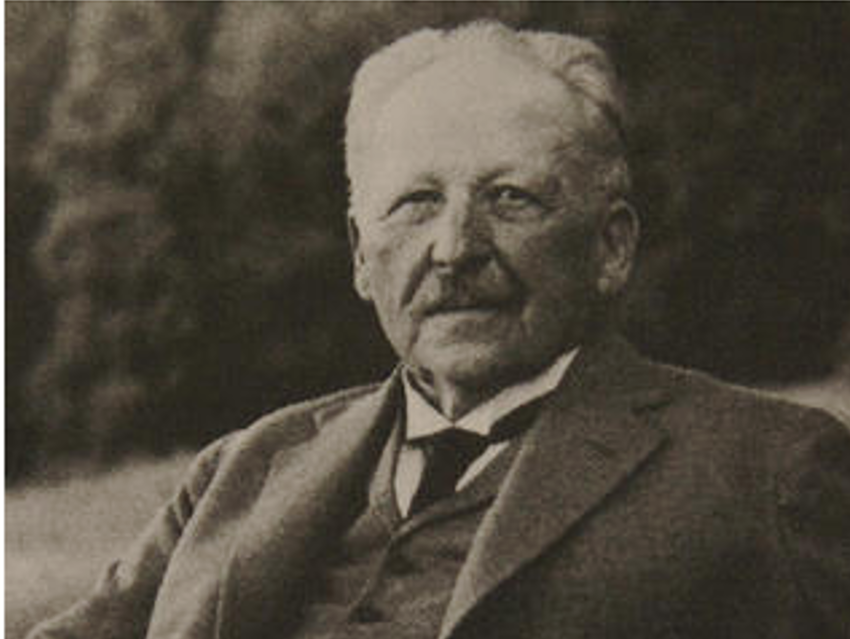Gustav Ludwig Friedrich Wilhelm Haarmann was born on May 24, 1847 in Holzminden, Germany. He studied chemistry first at the mining academy Clausthal, then at the University of Göttingen with Friedrich Wöhler, and from 1869 on at the University of Berlin with August Wilhelm von Hofmann. In 1872, he received his Ph.D. from the University of Göttingen with a dissertation entitled “Über einige Derivate der Glucoside Coniferin und Salicin”. Coniferine is the glucoside of coniferyl alcohol, which is contained in the sap of young conifer wood.
In 1874, together with his friend Ferdinand Tiemann, another student of Hofmann (who later became Hofmann’s brother-in-law), Haarmann succeeded in synthesizing vanillin for the first time [1]. In 1873, the Holzminden pharmacist Wilhelm Kubel offered Hofmann his materials on cambial juice preparations for further research. Haarmann and Tiemann found that coniferine can be oxidized with potassium bichromate solution and sulfuric acid to give glucovanillin by oxidative side-chain degradation. This is split into glucose and vanillin by treatment with acid or the enzyme emulsin [2].
Vanillin Factory
In 1875, Haarmann founded Haarmann’s Vanillinfabrik (“Haarmann’s Vanillin Factory”) in Holzminden for the industrial-scale use of their vanillin synthesis route. Tiemann aspired to an academic career and, therefore, only participated in the company as a silent partner, and remained available as a consultant. The first German patent was registered in 1877 [2,4].
Together with another of Hofmann’s students, Karl Ludwig Reimer, Haarmann succeeded in producing a more cost-effective synthesis of vanillin from eugenol, a component of clove oil. An iso-eugenol process developed by Tiemann in 1891 further reduced production costs. In 1878, the production of heliotropin and coumarin started. This was followed by the production of all kinds of fragrances. In 1893, the company also started the production of the violet aroma ionon, the most expensive fragrance, using a process invented by Tiemann [2].
Reimer joined the company in 1876. From then on, it was called Haarmann & Reimer. Haarmann & Reimer, together with its related company deLaire & Co, in Paris, France, deserves credit for having founded the artificial fragrance industry [2].
Wilhelm Haarmann died on March 6, 1931 in Höxter, Germany [3]. Haarmann & Reimer was bought by Bayer AG, Leverkusen, Germany, in 1953, and became independent again as Symrise, Holzminden, in 2003.
References
- Ferd. Tiemann, Wilh. Haarmann, Ueber das Coniferin und seine Umwandlung in das aromatische Princip der Vanille, Berichte der deutschen chemischen Gesellschaft 1874, 7, 608–623. https://doi.org/10.1002/cber.187400701193
- Otto N. Witt, Ferdinand Tiemann. Ein Lebensbild, Berichte der deutschen chemischen Gesellschaft 1901, 34, 4403–4455. https://doi.org/10.1002/cber.190103403176M.
- Bodenstein, Sitzung vom 9. März 1931, Berichte der deutschen chemischen Gesellschaft (A and B Series) 1931, 64, A37–A41. https://doi.org/10.1002/cber.19310640440
- Wilh. Haarmann, Patent DE 576, angemeldet 13. Juli 1877.
Also of Interest
- Chemistry Advent Calendar 2020
ChemistryViews 2020.
Daily highlights from the chemistry of spices - Vanillin Chemistry
ChemistryViews 2020.
We know vanilla from food and the kitchen and in this Clever Picture we want to take a closer look at what vanilla is - Clove Chemistry
ChemistryViews 2020.
We know cloves as a spice in the kitchen and in this Clever Picture we want to take a closer look at what clove is




